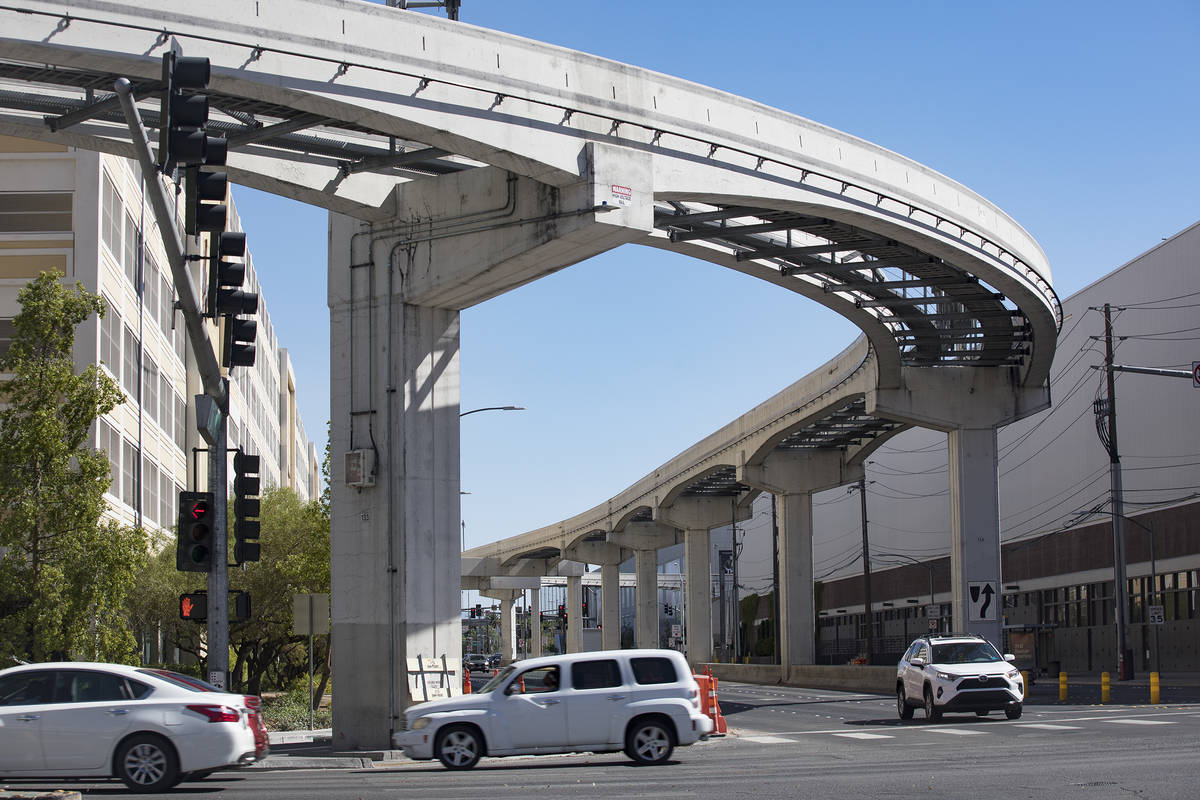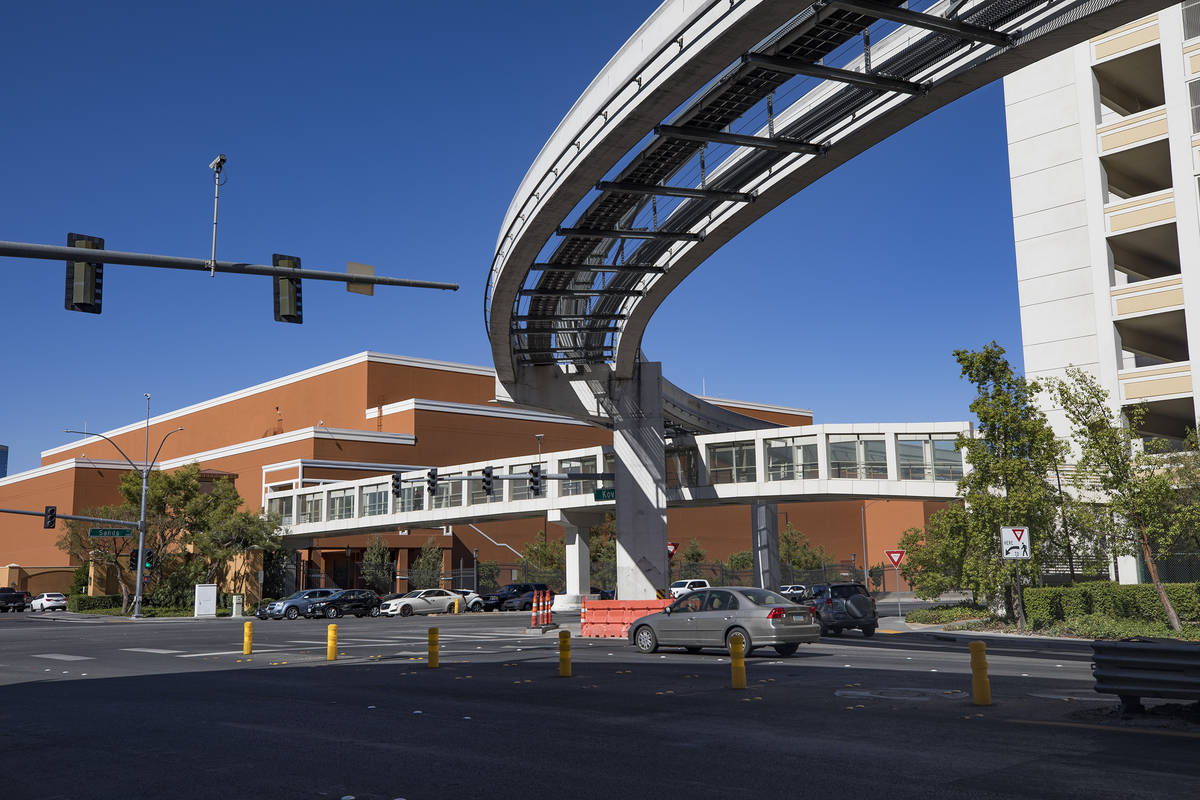Monorail directors to get pay cut with LVCVA purchase
Las Vegas Convention and Visitors Authority leaders believe they can operate the Las Vegas Monorail system at a lower cost than current management because they won’t be required to pay some of the expenses the company has.
LVCVA President and CEO Steve Hill on Tuesday cited lower costs for office space and not paying the company’s current board of directors as ways to reduce costs.
But there are other expenses that could be whittled once the system reopens and the LVCVA is in the driver’s seat.
The biggest expense is salaries, and the top four officers of the company receive a total of more than $1 million a year.
According to an IRS form 990 for nonprofit organizations, President and CEO Curtis Myles gets $361,728 a year, which includes $17,995 in nontaxable benefits, according to a 2018 filing, the most recent year available. A spokeswoman said no updates are available.
The monorail is a 3.9-mile electric transit system. Some of Myles’ transportation industry contemporaries receive far less in compensation for the broader oversight they’re responsible for.
Kristina Swallow, director of the Nevada Department of Transportation, which oversees 5,400 miles of highways with 1,229 bridges statewide, for example, is paid $125,434 a year. M.J. Maynard, CEO of the Regional Transportation Commission of Southern Nevada, gets $210,412 a year to oversee Clark County’s 10,053 miles of roads as well as multiple layers of public bus transportation.
Monorail executive pay
Other monorail executives and their pay include Ingrid Reisman, senior vice president of corporate communications, $251,794 a year, including $17,902 in nontaxable benefits; Peter McCann, senior vice president and chief operating officer, $263,209, including $29,120 in benefits; and Barrick Neil, vice president of operations, $233,536, including $25,505 in benefits.
According to the form, the top executives generally work 50 hours a week.
Reisman said Thursday that in addition to the layoff of 115 employees in March when the system shut down, top executives took up to a 30 percent pay cut.
The form said each director is responsible for about an hour of work a week on average. Paid $42,000 that year were Board Chairman Donald Shalmy and directors Bruce Woodbury, Virginia Valentine, Mark Russell, Michael Solow and Robert Manzo. Director Ryan Hammer received $38,500 that year and Rick Mazer, $3,500.
Reisman said when the system closed in March, directors were no longer compensated.
Hill also said the LVCVA would be able to provide office space and eliminate the rent the company pays for space in an office park on Howard Hughes Parkway. Annually, the company pays $116,043 for the space.
The company has other major expenses handled through independent contracts. According to the 2018 filing, the company pays $1.5 million annually to Las Vegas-based CA Group Inc. and $1.1 million for Los Angeles-based Gensler of Nevada for design and engineering work; $505,281 to DLP Services LLC for janitorial service; $436,356 to Los Angeles-based Kone Inc. for escalator maintenance; and $292,079 to Newport Beach, California-based Stradling Yocca Carlson as bond counsel.
Monorail’s origins
The Las Vegas Monorail had its roots in a short point-to-point system between the MGM Grand and Bally’s that operated for free beginning in 1995. Eventually, former McCarran International Airport director Robert Broadbent became the frontman for developing the system as it now exists.
In 1997, Nevada lawmakers approved legislation enabling a private company to run the system and a team consisting of Nevada-based Liaise Corp., train provider Bombardier Transportation, contractor Granite Construction Co., designer Gensler & Associates, engineer Carter-Burgess and financier Solomon Smith Barney was assembled to develop it.
Broadbent failed in efforts to place the monorail down the center of Las Vegas Boulevard when resorts pushed back. Instead, he developed a route east of the Strip with hopes that the system’s ridership success would lead to extending the system to the west side, to McCarran and to downtown Las Vegas.
The MGM-Bally’s section was shut down in 2002 and the new $650 million system was built with seven stations and nine Bombardier train sets.
The system opened in July 2004 but got off to a rough start during commissioning when parts fell off the train to the ground below. No one was hurt, but it damaged the system’s credibility from the start and the system had to be closed for four months.
Reopening in December 2004, the system was a hit for CES 2005, transporting conventioneers along the system to the Las Vegas Convention Center. Ridership hit its peak around 2007, when the system was transporting around 7 million passengers a year.
2010 bankruptcy
But as revenue declined, the company filed for Chapter 11 bankruptcy protection in 2010 in the wake of the Great Recession. Ambac Assurance Corp. insured $451 million of tax-exempt bonds used to finance the company’s purchase of the MGM-Bally’s line from MGM in 2000.
In court, Myles said that from 2004 the company used proceeds from the initial financing and debt service reserves to keep operating but had depleted those resources. He maintained that while revenue was sufficient to cover operations, it was never enough to service debt.
Once the company emerged from bankruptcy, it continued to struggle financially and was never able to fund some of the expansions leaders felt were essential to long-term success.
On Tuesday, when the LVCVA board of directors voted 12-1 to acquire the monorail for $24.46 million, Hill noted another bankruptcy filing is planned. This time, it will be a “prepackaged” bankruptcy that the court would have to approve before the deal goes forward.
Myles, at Tuesday’s meeting, declined comment about his plans. The LVCVA plans to choose a system operator at a future meeting, knowing that the system could become obsolete within a decade. Hill didn’t rule out hiring employees familiar with the system to operate it.
Late Tuesday, the monorail company produced an emailed statement.
“The Las Vegas Monorail has served a critical mobility need in the resort corridor for over 16 years, carrying approximately 5 million passengers annually and contributing to reduced emissions and congestion,” the statement said. “Like many other companies, we were forced to shut down on March 18 due to the COVID-19 pandemic and are not yet able to reopen. As a result, it is in the Las Vegas Monorail Co.’s best interest to file for bankruptcy and effectuate a sale of the system assets to a party who intends to keep the system in operation.
“The action (Tuesday) by the Clark County Commission and LVCVA allows this to happen, and will help ensure the mobility benefit the monorail provides during conventions, events and throughout the year in the resort corridor, continues.”
On Thursday, Reisman said the company’s lawyers have advised not to release any documents to the public until the bankruptcy is filed with the court.
Contact Richard N. Velotta at rvelotta@reviewjournal.com or 702-477-3893. Follow @RickVelotta on Twitter.
Moving the Monorail
Key dates in the development of the Las Vegas Monorail:
1995 — The MGM Grand-Bally's monorail line opens providing free rides.
2002 — MGM Grand-Bally's monorail closes to begin work on a $650 million seven-stop system.
July 15, 2004 — Las Vegas Monorail system completed.
Sept. 8, 2004 — System closes after parts fell off trains.
Dec. 24, 2004 — System reopens in time for CES 2005.
Jan. 27, 2005 — Federal government decides against funding a $400 million monorail extension to downtown Las Vegas.
Nov. 1, 2005 — Clark County Commission announces study to extend the monorail to McCarran International Airport.
2007 — Ridership peaks at 7 million a year.
Jan. 13, 2010 — Monorail company files for bankruptcy.
May 9, 2012 — Judge announces monorail can emerge from bankruptcy.
Aug. 29, 2014 — After years of being closed, the Sahara reopens as SLS Las Vegas, giving new life to the monorail's northern terminus.
July 14, 2020 — Las Vegas Convention and Visitors Authority President and CEO Steve Hill announces the LVCVA plans to acquire the monorail.
Sept. 1, 2020 — Clark County Commission and LVCVA board of directors approves LVCVA acquisition of the monorail for $24.26 million.



















